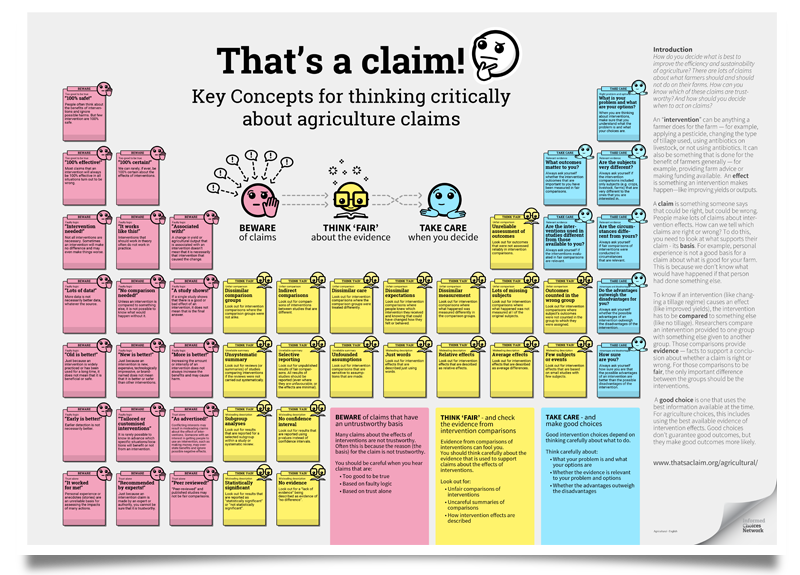Introduction
How do you decide what is best to improve the efficiency and sustainability of your farm? There are lots of claims about what you should and should not do on your farm? How can you know which of these claims are trustworthy? And how should you decide when to act on claims?
An “intervention” can be anything you do for your farm — for example, applying a pesticide, the type of tillage you use, using antibiotics on your livestock, or not using atibiotics. It can also be something that we do for the benefit of farmers generally — for example, making farm advice or funding available. An effect is something an intervention makes happen—like improving your yields or outputs.
A claim is something someone says that could be right, but could be wrong. People make lots of claims about intervention effects. How can we tell which claims are right or wrong? To do this, you need to look at what supports their claim – its basis. For example, personal experience is not a good basis for a claim about what is good for your farm. This is because we don’t know what would have happened if that person had done something else.
To know if an intervention (like changing your tillage regime) causes an effect (like improved yields), the intervention has to be compared to something else (like no tillage). Researchers compare an intervention provided to one group with something else given to another group. Those comparisons provide evidence – facts to support a conclusion about whether a claim is right or wrong. For those comparisons to be fair, the only important difference between the groups should be the interventions.
A good choice is one that uses the best information available at the time. For agriculture choices, this includes using the best available evidence of intervention effects. Good choices don’t guarantee good outcomes, but they make good outcomes more likely.
Three groups of guides
Many claims about the effects of treatments are not trustworthy. Often this is because the basis for the claim is not trustworthy. The first (pink) group of guides are things you should watch out for when you hear or read an agricultural claim.
It is always a good idea to question what evidence there is to support a claim. Evidence about the effects of interventions comes from intervention comparisons. The second (yellow) group of guides can help you decide how trustworthy that evidence is.
Knowing how trustworthy the evidence is can help you make good intervention choices. But there are other things you need to think about when you decide what to do and what not to do for your farm. The third (blue) group of guides can help you make good choices.
Using the guides
There are endless claims about interventions in the mass media, advertisements, and everyday personal communication. This includes claims about the effects of pesticides, GMO and; claims about more general agricultural changes, such as intensification; claims about organic farming and other types of “alternative” agriculture; and claims about changes in how agriculture is delivered, financed and governed.
Some of these claims are true and some are false. Many are not supported by trustworthy evidence: we do not know whether they are true or false. Claims about the effects of interventions that are not supported by trustworthy evidence often turn out to be wrong. Consequently, people who believe and act on these claims waste resources and may cause problems unnecessarily by doing things that do not help and might be harmful, and by not doing things that do help.
We developed the Informed Health Choices (IHC) Key Concepts as the first step in a research project with the aim of helping people make informed health choices. This website includes all of the IHC Key Concepts (guides). The IHC Key Concepts are the starting point for developing learning resources, such as this website.
The website and the poster can be used in different ways. For example, by finding examples of intervention claims in the media or by commercial companies and – using the guides – thinking critically and discussing how trustworthy those claims are and what you would do. For each guide, we have provided links to examples and some additional learning resources.
Please contact us and share your experience using this website and any suggestions you have.
We are an international group with decades of shared experience in health research, medicine, public health, design, education, communication and journalism. The agriculture section was produced by the Centre for Evidence Based Agriculture. You can find out more about us here.
This website has been developed by the Centre for Informed Health Choices at the Norwegian Institute of Public Health, InfoDesignLab, and the Epistemonikos Foundation.
Contact us
Please send us feedback, suggestions and questions about this website. Get in touch if you would like us to send you occasional updates about the website and other learning resources.
Email: ceba@harper-adams.ac.uk
